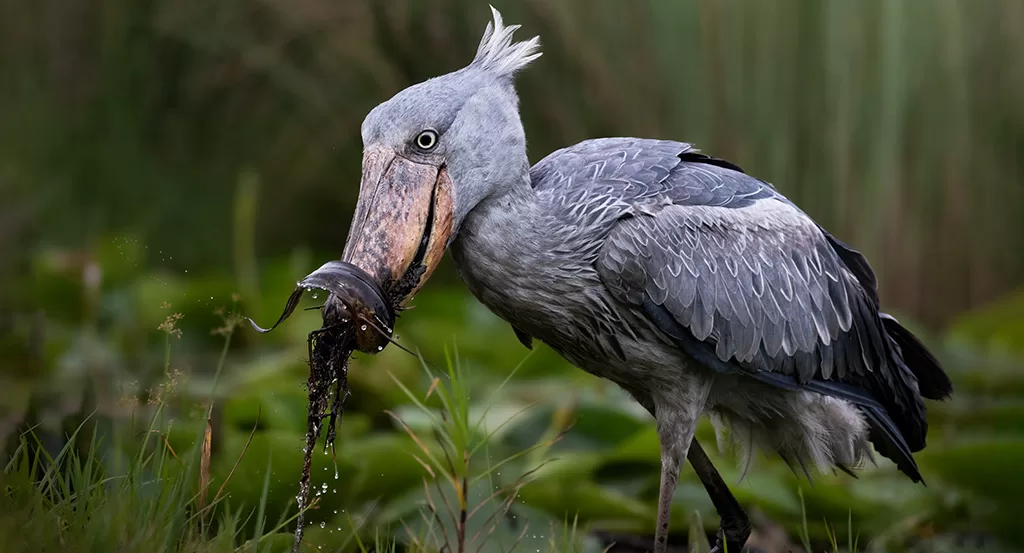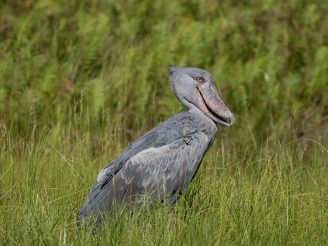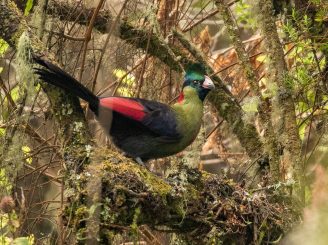Shoebill Birding in Uganda – Where to See Africa’s Most Unique Bird

The Shoebill (Balaeniceps rex) is one of the most mysterious and captivating birds on Earth. Standing over four feet tall, with long legs and a massive bill shaped like an old-fashioned shoe, this prehistoric-looking bird has intrigued scientists and birdwatchers alike. Its stillness, almost statuesque posture, and silent hunting technique make encountering one feel like stepping into a lost world, a time when dinosaurs might have roamed.
Uganda, often called the “Pearl of Africa,” is the ultimate destination to see the Shoebill in its natural habitat. Beyond this bird, the country offers a rich tapestry of wetlands, forests, and savannahs that are home to hundreds of other rare and endemic bird species. If you are a birder, photographer, or nature lover, a Shoebill-focused adventure in Uganda promises memories that last a lifetime.
Why the Shoebill Is So Special

The Shoebill is not just a big bird—it is an icon of Africa’s wetlands. Unlike other birds, the Shoebill moves slowly and deliberately, making almost no sound. Its massive, greyish-green bill is perfectly designed to catch lungfish, frogs, and even small reptiles, while its sharp eyes can spot movement from a distance.
When it hunts, it stands motionless for long periods, waiting patiently for the right moment to strike. This hunting style, combined with its prehistoric appearance, makes it seem almost mythical.
Unlike the more colourful birds, the Shoebill’s subtle grey feathers and solemn demeanour make it all the more mysterious. Birdwatchers often describe the moment of seeing a Shoebill as “magical” or “surreal,” and for many, it is the pinnacle of African birding adventures.
Best Places to See the Shoebill in Uganda
Uganda’s rich network of wetlands, swamps, and rivers provides ideal habitats for the Shoebill. Here are the top locations:
Mabamba Swamp – Just an hour’s drive from Entebbe, Mabamba Swamp is Uganda’s Shoebill capital. Guided boat trips allow visitors to quietly glide through papyrus channels, bringing you within a few meters of the Shoebill. Early mornings are perfect, with calm waters reflecting the bird and soft natural light ideal for photography.
Lake Albert Delta – Located along the Nile in western Uganda, this delta is another hotspot for Shoebills. Here, large wetlands attract both local and migratory birds, offering excellent opportunities to spot Shoebills alongside African Fish Eagles, herons, and other wetland species.
Murchison Falls National Park – The Victoria Nile, running through this iconic park, is home to Shoebills. Boat rides along the river not only give you a chance to see Shoebills but also allow you to enjoy crocodiles, hippos, and elephants along the riverbanks.
Lake Bisina and Lake Opeta – In eastern Uganda, these lakes are less crowded than Mabamba but equally rewarding. The wetlands here provide quiet habitats for Shoebills and other rare birds, making it ideal for dedicated birdwatchers looking for a more intimate experience.
The Best Time to See the Shoebill
Shoebills can be seen throughout the year, but there are ideal times for sightings:
-
Morning Hours (7–10 AM) – Birds are most active in the early hours, and the soft morning light makes photography stunning.
-
Dry Seasons – December to February and June to August are the best periods, as water levels are lower, concentrating fish and increasing Shoebill activity.
During these periods, guided tours can maximize your chances of seeing not just Shoebills but also a variety of other wetland and papyrus birds.
Other Must-See Birds in Uganda
Uganda is a birder’s paradise, home to more than 1,000 species of birds. While the Shoebill is the star attraction, there are many other rare and unique species:
-
African Green Broadbill – Found only in Bwindi Impenetrable Forest, this colourful bird is a treat for birders.
-
Papyrus Gonolek – A shy, red-and-black bird that hides in papyrus swamps.
-
Shelley’s Crimsonwing – One of Africa’s rarest birds, found in highland forests.
The country also offers a mix of endemics, waterbirds, forest species, and raptors, making every birding trip an unforgettable experience.
Essential Tips for Birders Visiting Shoebills
Spotting a shoebill in the wild is an unforgettable experience, but it requires patience, careful planning, and respect for the bird’s natural habitat. Here are some important tips for birders:
- Use Silent Paddled Boats
Shoebills live in swamps and wetlands where motorised boats can disturb the environment and scare away birds. The best way to navigate these areas is with small, quiet, paddled boats. These allow you to glide gently through the reeds and channels without making sudden noises that could startle the shoebills. - Bring Binoculars and Long-Lens Cameras
Shoebills are large birds, but they can still be difficult to approach closely. A good pair of binoculars will let you watch them from a safe distance, while a long-lens camera (at least 300mm) allows you to capture stunning close-up photographs without intruding on their space. - Avoid Loud Noises
Shoebills are naturally shy and wary of humans. Loud voices, sudden movements, or splashing in the water can cause them to fly away. Speak softly, move slowly, and maintain a respectful distance. The quieter and calmer you are, the better your chances of observing these magnificent birds in their natural behaviour.



